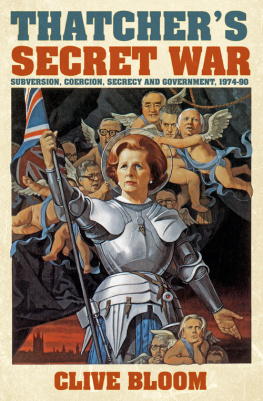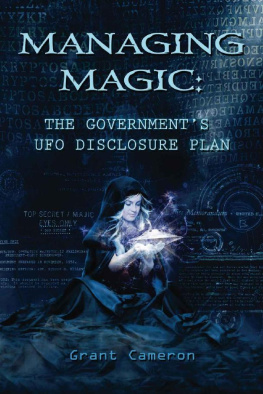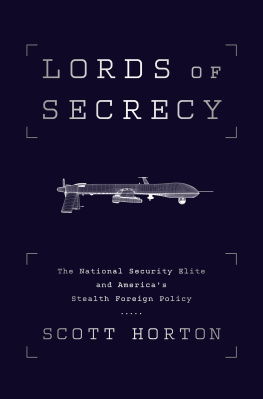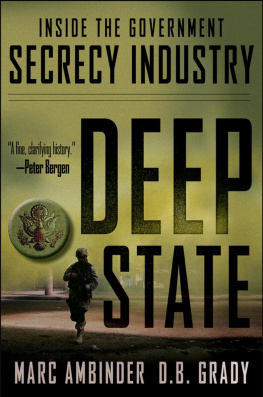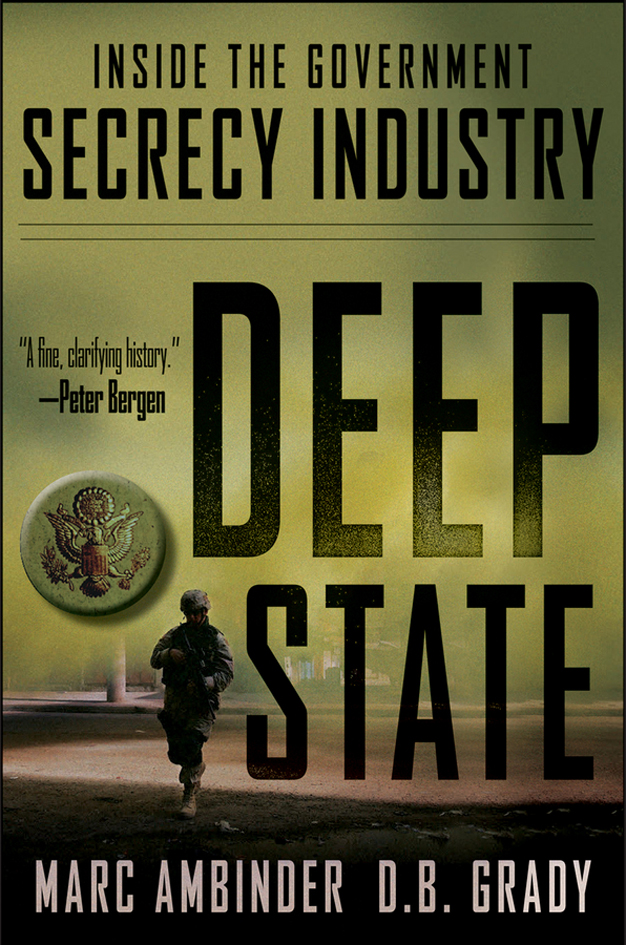CONTENTS

Copyright 2013 by Marc Ambinder and D. B. Grady. All rights reserved
Cover Design: Wendy Mount
Cover Photograph: Joe Raedle/Getty Images; Presidential seal Sylvia Schug/iStockphoto
Published by John Wiley & Sons, Inc., Hoboken, New Jersey
Published simultaneously in Canada
No part of this publication may be reproduced, stored in a retrieval system, or transmitted in any form or by any means, electronic, mechanical, photocopying, recording, scanning, or otherwise, except as permitted under Section 107 or 108 of the 1976 United States Copyright Act, without either the prior written permission of the Publisher, or authorization through payment of the appropriate per-copy fee to the Copyright Clearance Center, 222 Rosewood Drive, Danvers, MA 01923, (978) 7508400, fax (978) 6468600, or on the web at www.copyright.com . Requests to the Publisher for permission should be addressed to the Permissions Department, John Wiley & Sons, Inc., 111 River Street, Hoboken, NJ 07030, (201) 7486011, fax (201) 7486008, or online at http://www.wiley.com/go/permissions .
Limit of Liability/Disclaimer of Warranty: While the publisher and the author have used their best efforts in preparing this book, they make no representations or warranties with respect to the accuracy or completeness of the contents of this book and specifically disclaim any implied warranties of merchantability or fitness for a particular purpose. No warranty may be created or extended by sales representatives or written sales materials. The advice and strategies contained herein may not be suitable for your situation. You should consult with a professional where appropriate. Neither the publisher nor the author shall be liable for any loss of profit or any other commercial damages, including but not limited to special, incidental, consequential, or other damages.
For general information about our other products and services, please contact our Customer Care Department within the United States at (800) 7622974, outside the United States at (317) 5723993 or fax (317) 5724002.
Wiley also publishes its books in a variety of electronic formats and by print-on-demand. Some content that appears in standard print versions of this book may not be available in other formats. For more information about Wiley products, visit us at www.wiley.com .
Library of Congress Cataloging-in-Publication Data:
ISBN 978-1-118-14668-2 (cloth); ISBN 978-1-118-22580-6 (ebk);
ISBN 978-1-118-23573-7 (ebk); ISBN 978-1-118-26378-5 (ebk)
Sometimes, Tom, we have to do a thing in order to find out the reason for it. Sometimes our actions are questions, not answers.
John le Carr, A Perfect Spy
For Michael and Kelly
AUTHORS NOTE
This is a book about secrets, and the authors feel an obligation to be transparent about a few things.
During his time in the military, author D. B. Grady (which is a pseudonym for David Brown) held a security clearance. No sensitive information he came across while serving in Afghanistan or in the United States made it into this book.
In September 2012, author Marc Ambinder began consulting for Palantir Technologies LLC, an analytics company that does work for intelligence agencies and the Department of Defense, among other clients. He was brought in to work on a specific project that did not require access to secrets or to classified information. There was no cross-pollination; the manuscript had already been completed, and nothing in this book comes from any material gathered at Palantir.
Finally, both authors wrote extensively about secrecy while writing this book. Weve written tens of thousands of words on the subject, and have collectively written more than 20,000 posts to Twitter. If one compares our body of work to this book, it is possible that we have reused phrases or metaphors to describe certain subjects. If that is the case, it is entirely unintentional. Our brains dont compartmentalize the way that computers can. However, aside from some material about the U.S. Joint Special Operations Command that also appeared in The Command: Deep inside the Presidents Secret Army , the book is an original work in its entirety, the reporting is fresh, and the conclusions, we hope, are original.
While researching this book we stumbled across many things that we wont be able to write about. Though we have no legal obligation to submit our work to the government before publication, we have an ethical obligation as citizens to take extreme care when writing about sensitive subjects. We shared certain chapters with a number of former senior national security and intelligence officials, including several former directors of intelligence agencies. Our purpose was to learn if the publication of this book would truly jeopardize national security. After receiving the feedback, we asked ourselves whether there was a compelling reason to print the secrets in question anyway, and worked from there. We hope weve struck the proper balance.
INTRODUCTION
Asleep under Fire
On January 5, 2011, Mike Rogers, chairman of the House Permanent Select Committee on Intelligence, had dinner with the director of the Central Intelligence Agency, Leon Panetta, in a dining room at CIA headquarters in Langley, Virginia. After dinner, Panetta asked Rogers and his staff director, Michael Allen, to stop by his office. When they reached the seventh-floor office, Panetta shut the door. Weve got a bead on bin Laden, he told the two men. The CIA had tracked down Osama bin Ladens most trusted courier, and it turned out that the terrorist leader was holed up in an unusually constructed, well-crafted bunker-style house in a wealthy town in Pakistan just west of the Indian border. Come back in a few weeks and well give you the full brief, he promised.
Panetta had divulged to the Republican chairman the nations most precious secret at that timeand did so informally, and with a promise to provide more information. He did so without formally consulting the National Security Council. Over the next few months, he would find a way to make sure that the entire Gang of Eight, a group of eight leaders in the House and Senate, knew about the operation, the intelligence behind it, and the range of options the administration was considering. Rogers and Allen returned to Langley in February and took in two hours of discussion with the CIAs lead on the project. They pored over models of the compound and a variety of other intelligence, much of which remains classified. A few weeks later, Panetta called Rogers to let him know that the White House had chosen the most dangerous, most potentially valuable option: a U.S. Joint Special Operations Command SEAL team would storm the compound and kill or capture bin Laden. On the Friday before the raid, Panetta telephoned Rogers on a nonsecure phone line.
You know that thing Ive been talking about? he asked. Well, theres going to be something on it soon. Rogers knew exactly what the director meant.
Because the raid was successful, it is hard to determine what the reaction from Congress would have been had things gone south. On one hand, congressional partisanship had frozen the Senate in place. On the other, Rogers came to trust Panetta. And Panetta had not hidden a thing from him.
Allen would later tell Jeremy Bash, Panettas chief of staff, that Rogers was prepared to vocally defend the White House if the raid had gone bad. Even though the intelligence was equivocal, Panetta had the gumption and the foresight to share it with the Gang of Eight. A few weeks later, Rogers would get another call from Panetta, this one informing him about a more politically precarious secret: the United States had captured an al-Qaeda terrorist and was holding him on a U.S. ship in the Arabian Sea. Republicans refused to sanction any federal trial of terrorism suspects in the United States, but Panetta told Rogers that once the military and the intelligence community finished interrogating the suspect for knowledge about current al-Qaeda operations, he would be read his Miranda rights and transferred to the custody of the U.S. Department of Justice. Rogers could have squealed, or could have found some way to register his objections. But he did not. His interests and his institutions interests had been satisfied. In extending the umbrella, which risked compromising the administrations legal policy on terrorism, Panetta had instead depolarized the intelligence operation.






